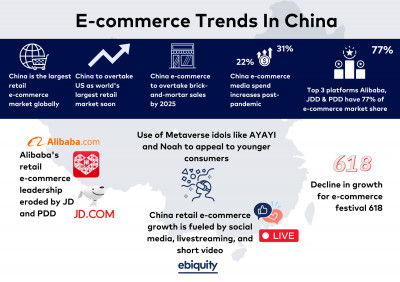E-commerce spends in China up from 22% to 31% post pandemic: Study
A study by Ebiquity, the world leader in media investment management, has found that the share of media expenditure on Chinese e-commerce platforms post-pandemic has grown by 9 percentage point for major advertisers. Compared to pre-pandemic (2018-2019), figure of 22% the on-site e-commerce is now (2020-2021) garnering 31% of total media investment.
This data was shared by Ebiquity China’s Stewart Li, Managing Director; and Bob Du, Senior Director of Analytics at a webinar hosted by the World Federation of Advertisers (WFA) on July 7, where the Ebiquity team also outlined keye-commerce trends in China along with advice on measurement of e-commerce investment in the market. The webinar was also joined by representatives of FirmDecisions, the largest contract compliance consultancy in the world.
E-commerce trends in China
A notable trend shared by the Ebiquity team was around the size of the Chinese e-commerce market, which despite a slowdown in growth during the pandemic retains its position as the world’s largest with 45.3 percentage of total retail sales coming from internet. It is forecasted (as per eMarketer’s trend report) that eCommerce share will take over brick-and-mortar sales in 2025.
Other trends include the erosion of Alibaba’s domination by JD.com (JD) and Pinduoduo (PDD); lower growth rates from the eCom Festival 618; use of Metaverse idols by e-commerce platforms to appeal to younger consumers and last but not the least, rise of short video live streaming, which is fueling growth for e-commerce platforms.
Stewart Li, Managing Director of Ebiquity China, said, “The last decade has been a decade of exponential growth for retail e-commerce in China. Research has shown that China will continue to lead the world in the e-commerce development in this decade, too, crucial for advertisers to understand the nuances of the evolving e-commerce trends and making the most of their investments.”
Measuring e-commerce investment in China
Ebiquity’s finding on 9 percentage point increase in the e-commerce investments in China has reiterated the importance of the e-commerce media channel for advertisers. That is why it is important for advertisers to understand the best ways to plan and measure their investments.
Ebiquity has outlined five points for advertisers to consider while investing in Chinese e-commerce platforms:
Biddable media cost can differ more than 100%
Considering almost all the e-commerce related buying in China is on biddable basis (be it on-site or off-site), it is important for advertisers to remember that the actual delivered buying costs regardless of cost-per-million (CPMs) or cost-per-click (CPCs), for the same buying platforms/ buying formats could vary greatly across different clients if compared to regular insertion order buys.
High CPC doesn’t always drive better ROI
When it comes to sales ROI, the most frequently used e-commerce KPI, Ebiquity research has found that higher CPC does not always convert to higher ROI. In most situations there doesn’t seem to be a correlation between the two.
Factors affecting the buying cost
The key drivers that contribute to the buying cost variations for biddable buys range from seasonality, audience targeting, optimisation to category/ product SKU. These factors are different from the ones impacting regular IO buys that include – negotiation power of clients/ agencies, agency group buying volumes, and existence of a media buying pitch.
Hottest e-commerce festivals do not guarantee the best ROI
Ebiquity research has found that while advertisers will witness higher CPC during the three hottest e-commerce festival periods in China, it does not necessarily achieve a higher ROI due to factors like campaign spending level, product SKU, pricing, promotion and store service level.
Getting the best value out of e-commerce investment
For advertisers to assess the the best value on their e-commerce investment, it is important to first review or audit a range of agency processes, aside from costs. The advertisers need to ensure the right data and tech are used in the optimisation process, ensure the right people are operating these data & tech to handle the optimisation and the aforementioned elements are transparently accessible, and last but not the least, make sure that their cost or performance is within a reasonable benchmark, which is key to any investment.
Besides having the reference benchmarks from external brands, advertisers can also procure meaningful benchmark, via their internal process management. Lastly, getting independent advice on how to manage the process correctly, or where to get a relevant benchmark. This will ensure they are making the most of their investment.
Bob Du, Senior Director of Analytics, Ebiquity China, said, “Accurate measurement of e-commerce investment for advertisers cannot be over emphasised. Our experience in the market has shown that advertisers need to employ a holistic approach is evaluating their e-commerce activity. We recommend focusing on four aspects – process, technology, people and cost vs performance – to achieve the best results. Developing the right frameworks and benchmarking are also vital and this is an area where Ebiquity’s expertise can be tapped by advertisers.”




Share
Facebook
YouTube
Tweet
Twitter
LinkedIn